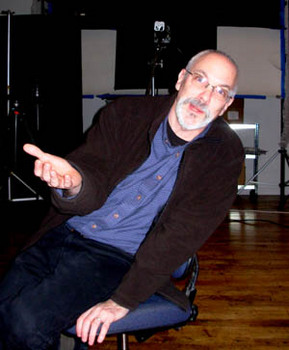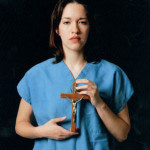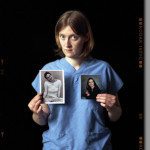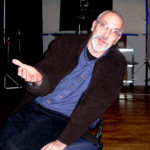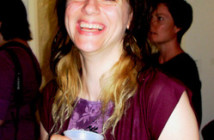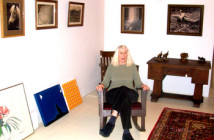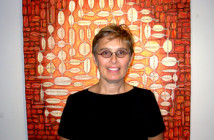January 4, 2006
The formally produced, studio portrait of Elspeth Kinnucan in blue scrubs, holding up snap shots of her two sisters proved to be riveting. She stares out at us with piercing blue eyes that are large and fixed. She is not just looking into the lens of the camera but staring us down with harrowing intensity. Clearly this young woman, at the time a first year medical student at New York University, is not just posing for a picture. She has something to say. A hard won lesson in life to convey to us. These eyes have seen and absorbed far more than you and I will ever know and experience. Arguably, she has become wise beyond her years in ways that most of us remain innocent.
There was a haunting quality to this unforgettable portrait that made it stand apart in a group exhibition of work by residents in the Eclipse Mill in North Adams, Massachusetts. The artist, Barry M. Goldstein, happened to be gallery sitting on the day when we visited. Astrid spent some time talking with him and told me later that he had offered to give us a copy of the catalogue related to that series of images.
During the Holidays we visited with Barry and his wife Andrea Barrett, an author of fiction, and their dog, Zoe. There were tea and cookies as well as slices of fresh pineapple. But it didn’t seem much like a social occasion with neighbors we are just coming to know. After a time of pleasant conversation I reminded him that I had come to learn more of his work. We repaired to his end of a large loft which contained the elements needed to produce high quality studio portraits. He explained that he had been taking photographs all of his life but made the transition into pursuing it as a full time activity over the past several years. Currently, Goldstein who is an M.D. with a Ph. D., is winding down as an Associate Professor of Medical Humanities at the University of Rochester School of Medicine and Dentistry. His research field involves bio chemistry and bio physics and what he described as structural biology.
During 2001, Andrea was a fellow at the New York Public Library and Barry, while on sabbatical, had a one year appointment as Visiting Professor in Humanism in Medicine at the New York University Medical School. His stay at NYU was sponsored by the Master Scholars Program and he planned to teach medical students about the history of photography in medicine. He also hoped to pursue a project involving photographing doctors and their patients in a manner in which their roles and identities would remain anonymous.
They arrived in Brooklyn in July and were faced with making a “hole in the wall” inhabitable. It was a formidable job just to get settled and prepared to pursue their work and research. While he finds teaching gratifying and enjoyed the intellectual curiosity of pursing pure research, “I wanted to do a sabbatical in another area. Andrea supported my creative side while many of my colleagues did not. It was difficult for them to understand why I wanted to do this. What interested me was portraiture. The dichotomy between studio portraits where one has complete control of all of the elements of lighting and setting and documentary photography where one has no control of the circumstances. But there is the aspect of telling a story. The ability to capture a story through a picture.”
After struggling to make the living space comfortable, initially there was no hot water, the first official day of reporting to work at NYU proved to be 9/11. “The shit hit the fan,” he recalled. “From the street I heard that one of the buildings was on fire. We were in Brooklyn right on the river. I went up to the roof with my camera gear and photographed. Taking pictures was a means of shielding myself behind the lens from what I saw. I set up my equipment and photographed for about an hour and saw both towers collapse.”
There was a detour from his account as I asked about his motive and in what manner he was sheltered from the experience by looking at it through a lens. He caught a train, virtually deserted, into Manhattan and photographed getting as close as he could to Ground Zero. “Trust is an issue,” he responded. “You have to be honest with the subject and yourself as to motives. The notion of being purely altruistic is a fetish. If you tell yourself you are doing this solely to show the world some great truth of which you are the objective observer then you are lying to yourself and the subject.” He talked about bearing witness and sharing what others were not able to see and experience.
In the later portrait project which entailed photographing and interviewing some 18 first year med students who had volunteered in the makeshift morgue he had to be clear on his intentions. “You gain self interest in any portrait project,” he said. “The strategy is to be honest about that. When I approached the med students they asked what you want to do with these pictures and interviews. I planned to exhibit them and eventually to seek funding for a book.”
On 9/11 he got to within four blocks of Ground Zero and photographed for about 14 hours. He had recently purchased a stock of Fugichrome 35 MM slide film and shot most of the brick of 20 rolls using a Nikon camera. He used 200 ASA film which was pushed one stop in development. As he photographed he recalls that, “I was horrified and fascinated. Downtown was abandoned most people had fled the area. There were hundreds of huge Army trucks taking away debris. Eventually I went back to Brooklyn and got Andrea to come with me. We went to Chelsea Piers the next day. Within hours I had slides processed and started to scan them and sent images to an on line news site. There was a need to be a witness. They posted a story and I could send that to friends. I just wrote short captions.”
After we concluded the interview he brought up an animation of the images he had shot right after the attack on the World Trade Center. But he walked away and said that he didn’t want to look at them. I urged him to stay and give me some comments but it was clearly disturbing to relive the memories. In fact he has not subsequently viewed any of that material and other than that initial on line posting has done nothing with them. He explains that there are a lot of 9/11 images available and that he has nothing to add. I asked Andrea about her responses and got a similar reaction. She explained that all that year she wrote only one 20 page article, a non fiction account of her experience, for a scholarly journal. She offered to loan me the journal but said that it was her last copy and I didn’t want to take on that responsibility. But I do hope to read the piece at a later time. Because of the trauma, where earlier novels have averaged three years, this latest one has taken more like six years and is still in process.
Both of them refer to that year in New York as rough. Clearly they much enjoy being out of the city and pursuing life in the Berkshires. That fellowship/ sabbatical year that had started with so much potential became daunting. And in January they had to move to Manhattan. The project to photograph doctors and patients just wasn’t going anywhere. By April Barry focused on the notion of photographing and interviewing the medical students. The timing proved to be fortuitous. By then the work in the morgue, which at its peak required a thousand individuals and involved a blocked off street with tents and refrigerated trucks next to the 96,000 square foot medical examiners building, was pretty much over although it continues to this day. The students by spring were settled into their studies but still sorting out experiences and emotions. A couple of students declined being involved with the project. For the rest Barry asked them to come in scrubs, which they had worn in the morgue, and to bring a prop or object that had been helpful in getting through the horrific experience. In addition to photographing he interviewed them for an average of an hour repeating basic questions.
When the students volunteered to work in the morgue most of them had barely started their studies. With no real experience just how might they be helpful. They were used primarily as scribes taking notes dictated by medical examiners and criminal investigators. They also handled body parts.
In the forward to the book that Goldstein published through NYU, Charles S. Hirsch, M.D., the Chief Medical Examiner of the City of New York, discussed the process and results. “We have identified 1585 (58%) of the 2749 persons reported missing. Only 39 (2.5%) of those identifications were made by personal recognition of the victims, the remaining 97.5% were unrecognizable, in most cases because the victims were fragmented. Many identifications were made by dental records and finger prints, and a modest number were made by unique personal artifacts. However, DNA comparison was the leading identification technique. In total, 1372 persons were identified by DNA, 528 in combination with other modalities and in 844 as the sole modality. Without DNA we would have identified only 741 (27%) of the fatalities, and our efforts would have concluded in May, 2002 with no hope of further identifications.” He added that, “I had 35 years of a professional life devoted to forensic pathology to prepare me for 9/11. In contrast the students were confronted by the monstrous consequences of the disaster while still in their professional infancy. And they did it admirably. They successfully navigated an extremely turbulent experience, and they made invaluable contributions to our efforts. But what was their personal; cost and sacrifice?”
Beyond making the images and recording the interviews it took another couple of years for Goldstein to see the project through to publication. In his typically low key manner he just shrugged and gestured to convey the complexities of completing the project. A part of that was convincing NYU to establish the Master Scholars Press of which this is its first, but, hopefully, not last publication.
“We printed an edition of 3,000,” Barry said. “Last June we gave 1,500 copies to all of the graduating medical students in the city of New York. They were the class that had started in September of 2001.” "That must have been gratifying" I said. “Not really,” he answered, “I never heard from any of them.”
After reading the piece Barry did recall making that remark but added this important comment. "I did hear a great deal from the students in the book and their families, and their responses were immensely gratifying. I really didn't expect to hear from the students from the other schools, since they were graduating, and about to head off to their internships, and so were bound to be very, very busy. However, the fact that the other schools (Cornell, Einstein, Down State, Sinai and Columbia) wanted these books for their graduating students is still a source of pride for me. Lastly, and at the risk of protesting too much, I've heard from a number of colleagues who've seen this at meetings etc. or read about it, and again, it is a source of immense gratification."
Yes, but silence from so many of the 1,500 recipients of the book, other than the exceptions that Barry notes, and a lack of greater feedback may be deceptive. It is hard to measure responses to trauma and memory that most people are struggling to put behind. Perhaps not right now, it is still too soon, but with time Goldstein’s project and poignant book will play a useful role in conveying how these few brave young people, literally, picked up the pieces and helped so many families find some closure. His thoughtful project is hard to deal with and even harder not to deal with. It deserves a wider audience.
"Being There: Medical Students Morgue Volunteers Following 9/11: Portraits and Interviews" By Barry M. Goldstein is available from Master Scholars Press, New Yourk University School of Medicine.
Goldstein image courtesy Charles Giuliano.
Artworks courtesy of the artist.

